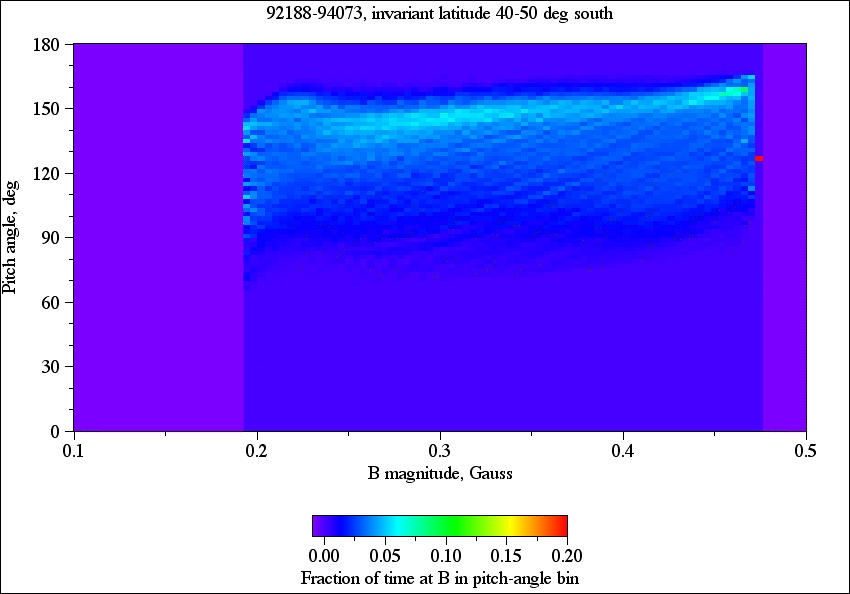
There have been four major algorithms used to steer the attitude of the SAMPEX spacecraft over the mission: the original "Orbit-Rate Rotation" mode; the "j-perp" mode, intended to increase exposure to trapped anomalous cosmic rays (ACRs) in the South Atlantic Anomaly region; the 1-RPM spin mode; and the current mode, which is "j-perp" without the ram-avoidance constraint originally included to protect the front foils of the HILT instrument while it still had gas pressure. This page presents a long-term look at the amount of time each of the three non-spinning modes has allowed the instruments to observe nearly perpendicular to the local magnetic field. The pitch-angle coverage varies substantially within the three-month half-period of the orbital precession, but during a given pointing mode the individual three-month averages do not look much different, and so I have added together several such averages to produce each of the following plots.
All six-second samples during each three-month precession half-period were binned by invariant latitude (with positive or negative signs assigned to indicate which hemisphere), magnitude of B, and pitch angle (corrected per the late Tom Flatley). The first three plots focus on the trapped ACR region, around 40 to 50 degrees invariant latitude in the southern hemisphere; the color scale indicates the fraction, of all the time spent at this invariant latitude range in a given B-magnitude bin, that the spacecraft spent in each pitch-angle bin. Thus the sum of the values in each vertical column, i.e., for each value of B, should be unity; values less than zero (purple) indicate that the spacecraft never reaches the given value of B in this invariant-latitude range. The first plot is for the original "Orbit-Rate Rotation" pointing mode.

As can be seen, the fraction of time spent looking near 90 degrees in this physically interesting region was, on average, not impressive; thus the pointing strategy was revised to point the instruments nearly perpendicular to the magnetic field when the spacecraft was in the South Atlantic Anomaly region, identified by a magnetic field strength below 0.3 Gauss. The result of this is shown in the next plot.
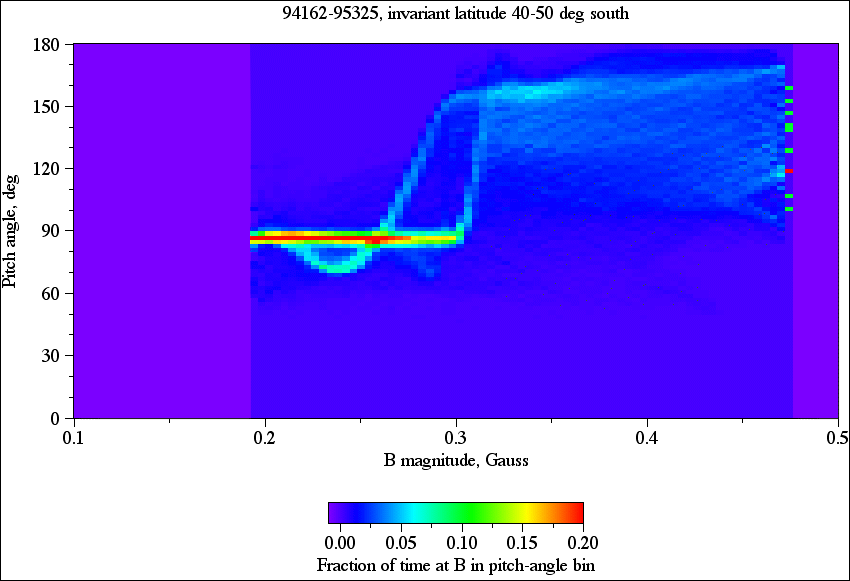
A marked improvement resulted, as indicated by the strong band near 90 degrees for B less than 0.3 Gauss, as advertised. Note, by the way, that all plots on this page are assembled from complete three-month precession half-periods, to average out precession effects; thus days 94074-94161 between the times of the two plots above were discarded, since part of this span was spent in each mode. After the end of the time period in the plot immediately above, testing and then implementation of the 1-RPM spin mode occurred, which pretty much homogenized pitch-angle coverage and is not of interest here.
When the two years of spin-mode operations ended, the spacecraft was placed back in the "j-perp" attitude control mode, with the difference that the ram-avoidance constraint was deleted from the algorithm since there was no longer any need to protect the HILT front foil from isobutane leaks caused by micropinholes. This meant that the instruments could spend more time looking perpendicular to the field without having to flinch away from the ram direction, as shown in the next plot.
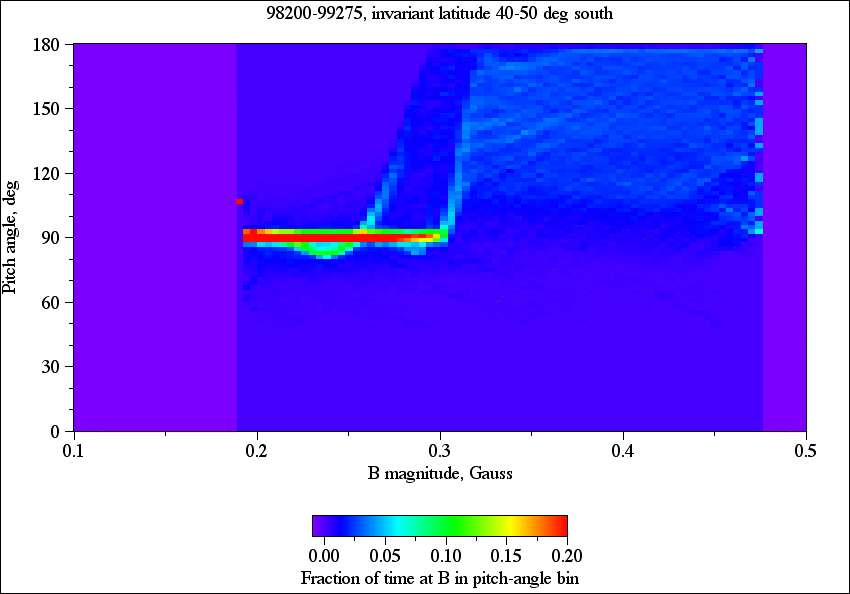
Note that the band of color near 90 degrees pitch angle for B less than 0.3 Gauss is even stronger than in the previous plot, indicating that the ram constraint removal resulted in the expected improvement. This is the current (as of this writing) operating mode; no days after 99275 are included in the plot because of "contamination" of subsequent three-month periods by days spent in the 1-RPM spin mode.
Of course, given the rather large acceptance cones of the SAMPEX instruments, the two-degree width of the pitch-angle bins in the plots above is too fine a distinction to be discernible. The cut I have typically used in my analyses of trapped particles is to allow pitch angle to be within ten degrees of perpendicular to the local magnetic field; the following three plots show the fraction of time, in a given B magnitude and invariant latitude bin, spent looking within this twenty-degree pitch-angle window (80 to 100 degrees). The three plots are for the same time periods as the plots above; values less than zero (purple) indicate that the spacecraft spent no time in a given B and invariant latitude bin.
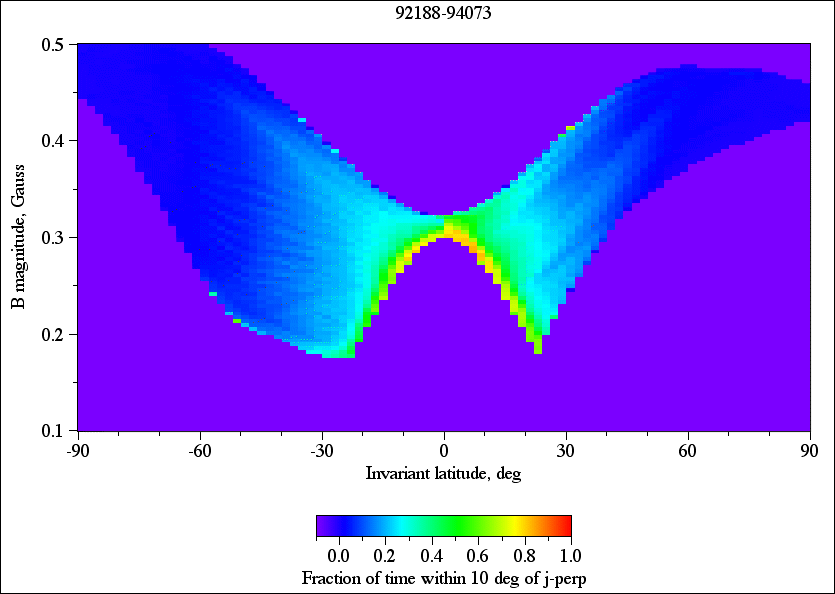
In the original pointing mode, only near the magnetic equator did the instruments spend a large fraction of the time looking nearly perpendicular to the magnetic field, averaged over the precession. The change to the "j-perp" mode made a big improvement, as shown in the next plot.
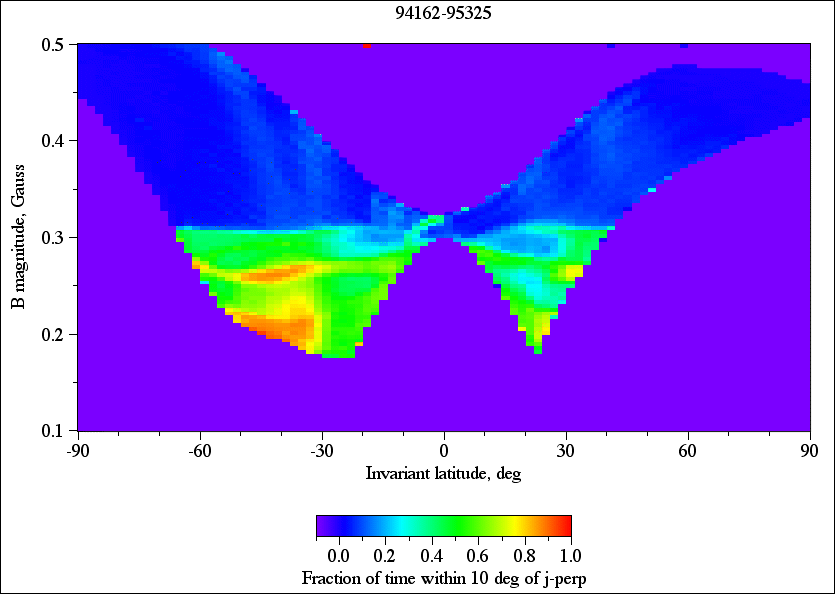
For B less than 0.3 Gauss in the southern hemisphere, around half the time the instruments were looking at the desired pitch angles, with improvements toward the lowest values of B. The next plot shows the improvement resulting from removal of the ram-avoidance constraint.
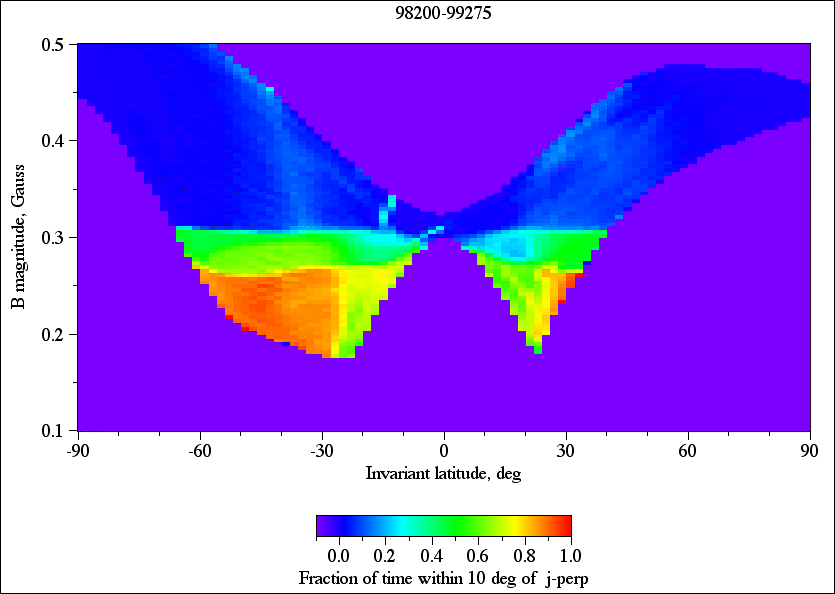
The improvement made in the current pointing mode is larger than I would have expected it to be: for invariant latitudes greater than about 30 degrees (L greater than about 1.3) and B less than about 0.26, 80% to 100% of the available time is spent looking perpendicular to the field! Thus any improvement brought about by the removal of those annoying flips near the magnetic equator would only contribute substantially at the very lowest values of L, and even then would have to improve on the 50% fraction already achieved, i.e., less than a factor of two. So unless experimenters studying the outer-zone electrons wish to extend the "j-perp" region to higher L by pushing the boundary between "weak-field" and "strong-field" pointing algorithms above 0.3 Gauss (which would probably interfere with cosmic-ray cutoff studies...), I would say that the current pointing strategy is not going to be improved enough to justify further modifications.
 Back
to top of Data Pages
Back
to top of Data Pagesnew 4 March 2000